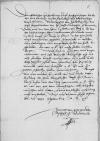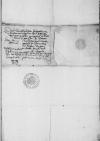Dem durchlauchten, hochgebornen fursten und herren, hern ⌊Albrechten⌋, von Gots gnaden marggraf zu ⌊Bran[den]burg⌋, / in ⌊Preussen⌋, / zu ⌊Stettin⌋, [⌊Pomern⌋, d]er ⌊Cassuben⌋ und ⌊Wenden⌋ [hertzog, / bur]ggraff zu ⌊Normberg⌋ [und furst] zu ⌊Rugen⌋, / unseren [hochgunstig]en, lieben herren und freunde
Durchlauchter, hochgeborner furst, hochgunstiger, lieber her und freundt. / Unsere freuntliche und vleiswillige dinste zuvoran. /
Underwegens von ⌊Heilsberg⌋ sein uns diese ⌊⌋ von hern ⌊Jobst Ludwigen⌋ zukommen, / dobei auch von dem hern ⌊castellan von Bÿetz⌋ etc., der uns des hochwirdigen hern ⌊confirmirten zu Lunda unnd Costentz⌋ ⌊⌋ zu ⌊Brug⌋ in ⌊Flandern⌋ den XII Iulii negst vorschinnen gegeben, / ⌊⌋, / in welchen diese zeitungen, / wie eingelegte zedel ein helt, / beschrieben, / die wir Ewer Furstlichen Durchlaucht nicht haben wollen bergen. / Was sonst in ⌊Hungern⌋ wirt vorgenohmmen, / und wie ⌊romische konigliche maiestet⌋ mit acht fenlein knecht / und anderm fussvolck, / dobei dreÿ tausent pferd, vom ⌊Hainberg⌋ gen ⌊Presburg⌋ vorruckt, / wirt ane zweiffel Ewer Furstliche Durchlaucht aus hern ⌊Jobsten⌋ ⌊⌋ haben zuvornehmen. / Kompt uns was anders zu, / wolle wir aus dieser tageleistung der hern ⌊koniglichen rethe⌋ zu ⌊Graudentz⌋, / dohin wir den weg genommen, / Ewer Furstlichen Durchlaucht, der wir von Got dem almechtigen alle seligheit wunschen und bitten, / freuntdinstlicher meynung nicht vorhalten. /
Datum aus unserm hoffe ⌊Schmolein⌋, den XXV Septembris / M D XL.
⌊Joannes⌋, von Gots gnaden bischoff zu ⌊Ermelandt⌋ /
manu propria subscripsit



